Adaptive Strategy - 25 Years Of Lessons In Strategy From DuPont With Peter Compo
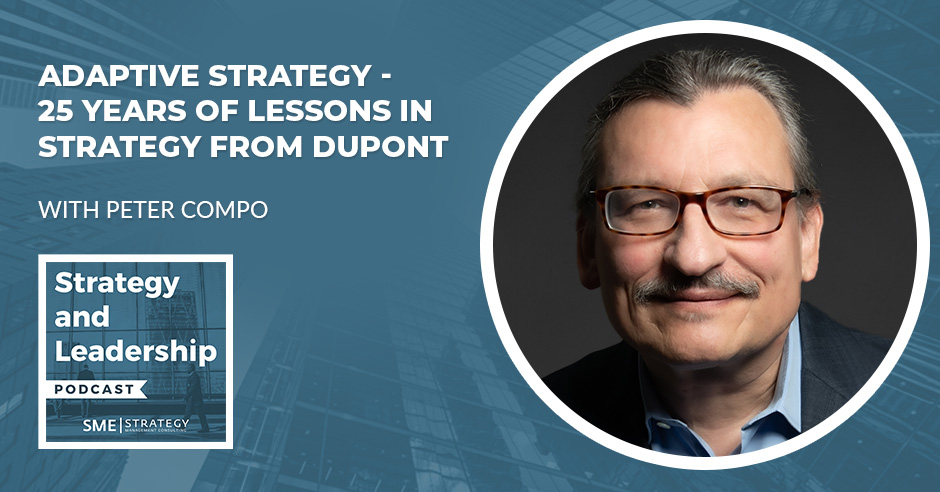
Adaptive strategy is an ingenious approach that has been the secret sauce behind the longevity of iconic companies. In this episode, we sit down with Peter Compo, the author of The Emergent Approach to Adaptive Strategy, Design, and Execution, who shares profound insights gained from his 25-year tenure at the global giant DuPont. Explore how DuPont, a company steeped in tradition, faced the daunting challenge of reinventing itself in a rapidly changing world. Dive deep into the strategies they employed to foster innovation and adaptability. Peter's unique perspective sheds light on how to navigate the complexities of change and emerge stronger than ever. Stay tuned as Peter unveils a transformative takeaway that can revolutionize your strategic approach, regardless of the size or nature of your business. If you're eager to gain a fresh perspective on strategy, innovation, and leadership, then tune in!
Listen on Spotify: https://open.spotify.com/episode/5N8eiVSv7mt6ktmmWd2tR0?si=c683a991ca624b23
---
Watch the episode here
Listen to the podcast here
Adaptive Strategy - 25 Years Of Lessons In Strategy From DuPont With Peter Compo
In this episode, my guest is Peter Compo. He is the author of The Emergent Approach to Strategy: Adaptive Design & Execution. He spent 25 years in the same organization. I'm so excited to share the adaptive learning from his work. Peter, thanks for joining me. I'm looking forward to having a chat and learning more about your work and your book.
Thanks for having me.
I was trying to be a little coy with it, but can you tell our audience a little bit about your experience in the organization that you work with and a little bit more about you, and we will get into the chat?
I spent 25 years at EI DuPont here in Wilmington and in a few locations. It’s now a much smaller company than when I joined and has gone through a breakup. The parts that have been broken up and what it was when I first joined was one of the great companies of the twentieth century. Its heyday was in the earlier part of this century when they invented so many products that became household names like nylon, freon, and stain master. Also, many commercial things like Kevlar and Tyvek. It was a great company. Its parts still are, even though it's been broken up. I joined as a chemical engineering scientist. I experienced quite a wide range of positions in the company. I had leadership positions in operations, supply chain, marketing, and product.
I worked in new ventures as the Director of DuPont Ventures for a short time, and then I worked in old commodity businesses. I had a good view. I talk about it having worked in the corporate trenches for 25 years. Over that time, I saw a lot of ways that strategy was thought about. I saw a lot of ways that innovation was thought about. We had an army of consultants. All the big names were coming through year after year, and I saw what they were saying. I felt compelled to think about things a little differently and bring new clarity, as I say, to strategy, design, and implementation.
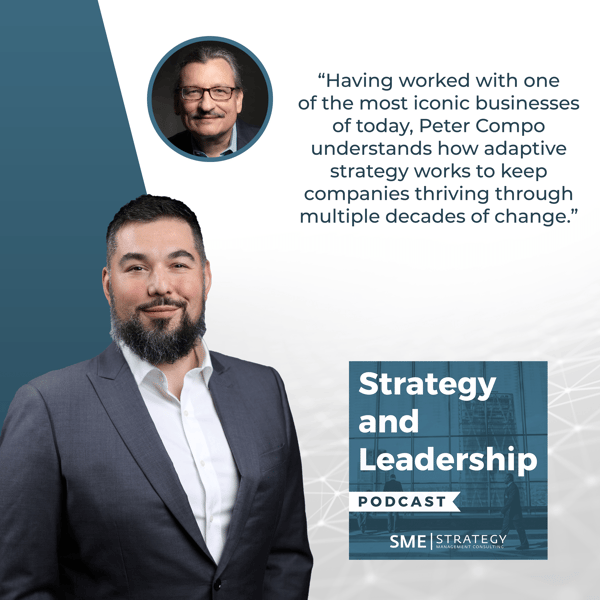
I will add one other thing. I come from a musical background. My family was all musicians in New York. That gave me a background that was important too, because one of the things we have to do is connect strategy methods to how creativity occurs and how innovation occurs. It doesn't occur by stepwise recipes. It's ugly and it's messy. Only in hindsight are we able to take history and say, "They must have known what they were doing all the way." In a few cases, you can find people who got lucky enough to know it all the way. I have tried to integrate this whole angle of how creativity occurs adaptively. Slowly all of these experiences came together, and I quit to write full-time and get a book out that tried to capture all of these issues that I had experienced.
Innovation doesn't occur by stepwise recipes. It's ugly and it's messy.
I'm interested in reading the book. I have got a shelf of 40 to 60 years of Management Science. What I think is cool about your experience is, that when you look at innovation in the 21st century, whatever the heck century we are in right now, you are looking at technology leveraging. You are building technology on top of additional technology. You have AI morphing with other modules of AI to support that.
It's so cool from the company that you worked in and the background in Chemical Engineering. You are like, "Let's mix these things and make a new compound." The amount of risk tolerance, creativity, and innovation to create a compound like a physical thing that never existed. We are not talking about a beverage or food. You are talking about industrial applications and the trillions of dollars, but then also getting a whole line of consumers to use it. That in itself, the product launch needed to implement any launch successfully.
The depth and breadth of DuPont as an organization, and as you mentioned, "You have got the brightest minds in the world," consultants will say. You have your internal methodologies. You have internal engineers, and the engineers are the smart guys. You then have consultants coming in. Just the ability to be able to morph, adapt, grow, and change so quickly, but having so many minds of people working on a way to make it happen, I could only imagine how interesting that would be.
As a practitioner, I am in my way every day, and I'm evolving my models from 1 to 2 to 3, and I'm using those books. You guys were on the front line of it and I can only imagine what that was like. Getting into a question. What was it like in the 25 years in that organization the arcs of innovation of the ideas and how it's evolved? Take us as deep into the trenches as you'd like to go.
Looking back, the famous inventions of the company occurred before I got there, and the company was almost 200 years old when I got there. They had started the first 100 years with explosives, and then they parlayed that explosive chemistry, and had cellulose chemistry, which was from dynamite. They said, "Let's start looking at other chemistries." Slowly but surely, they branched out into all kinds of chemically related technologies and platforms including inventing nylon along the way and the whole polymer world, along with some other great companies in Europe and Asia.
What was interesting about strategy in DuPont for me was, when I joined, the question was, "How are we going to do it again? How are we going to reinvent this company for a third time?" A company that reinvents itself once is brilliant and has survived for 200 years. To be able to do it a third time, it’s a great challenge. What I think they were up against is something that so many companies are up against. It's questions like, "How long to hang in there with legacy products? How long to hang in there with old platforms that got you there in the first place?" I know I wasn't there, but I know there were times people would say, "We are going to keep investing in nylon because that's what got us there."
A company that reinvents itself once is brilliant. But to be able to do it a third time is a really great challenge.
Yet, maybe the company was ten years too late in moving out of nylon and saying, "This is now a commodity. We can't afford to be the producers of this anymore. It's time to move on." That was something that DuPont and all maturing companies had to face and was very difficult. Frankly, maybe didn't face it as hard as they could have. That was part of the reason why the corporation had to be broken up a little bit.
There's also the problem of how fast you can change. They did a brilliant thing. They said, "We had 100 years of explosives. We had 100 years of chemistry and materials. What's the future?" It's biology. That's where the new opportunity is. It was a brilliant idea to do that. The question came down to, "How fast could you move? How fast could you get out of the old stuff and still justify the corporate overhead of a huge R&D division and all the overhead of a C-Suite?" All the various parts came with running a global company of that size.
That's where I saw something and where you needed a brutally harsh strategy to do that. I wonder if your show speaks to small businesses and medium-sized businesses. How many businesses are feeling that maturity coming on and having to make some very tough decisions and that the innovation requires a very harsh strategy on how to take those choices?
That's so interesting to hear, the 100-year perspective looking at your tenure from 1988 to 2013. The natural macroeconomic changes that have happened. I find it so interesting running a business now, the speed of change. I was meeting with somebody who's doing social media and he said, "Every five years, I need to reinvent myself." That is a very niche technology.
As you look at an organization like DuPont and how it's grown and evolved, you have such a legacy. The question I was wondering in my head that I'd love to post to you is what were the biggest challenges in accepting the change, putting the strategy in place, and moving it forward? Was it size? Was it scope? Was it resistance? Was it communication? Was it integration? Was it launching business lines?
To your point now around SMEs in this day and age, their ability to be nimble and to be adaptive with their strategy is one of the musts. It's interesting to see an organization that was big and now it's broken up to presumably be more nimble, adaptive-focused, and then how does an organization, those big behemoths, the trillion-dollar market cap companies, what are they doing? It's a very interesting dichotomy. What was your experience? What were some of the challenges that you saw or the chief challenge in driving strategy and adaptive strategy forward?
DuPont is a good case for that question in the sense that DuPont was nothing like Kodak, which also had its heyday versus the same time that DuPont had its heyday. Kodak got slammed by one thing. They didn't react quickly enough. The story is they had the first digital camera, and yet they let they let others take it away. It wasn't like that at all. DuPont was a well-run company. It's a professionally run company. It's successful.
I remember one year that we had trouble with the stock price, and there were complaints from the analysts and so forth. I remember the CEO at the time said, "We made $3 billion this quarter," or whenever it was. What I think was interesting and what can be learned from it is that these things sneak up on you. It's very hard to know when it's time to pull the trigger, when it's time to let go of the old product lines and sell them, and when it's time to put big money into new things.
It's hard, but I think not only was DuPont a little slow in doing it, but I think that we didn't get enough out of the old businesses to finance the new. We weren't rigorous enough about making money in the old businesses and getting the absolute most we could out of them. That wasn't just too many people, which we did have. That was born out as they started to break the company up into parts, and many people lost their jobs, unfortunately. As I watched this, we didn't have enough efficiency and enough success in the existing old businesses to properly finance the new businesses.
You asked a question about resistance. I don't know that it was resistance. It may have been more along the lines as it wasn't clear what to do and there wasn't great clarity. I will add the last one, which was the toughest of all, having to achieve quarterly results that keep the stock price going. Frankly, you could make a great 5 to 10-year vision and plan. You might think it's right, we had high-power consultants come in here and tell us it's right. When that quarter comes, it can change things and it can change focus. That was another tough thing. That was very related to not getting enough out of the existing businesses.
I see it with public organizations. It's like you are stakeholders. You are so accountable to your stakeholders. I say it's above my pay grade. I'm not a public CEO and I can't sit here and say, "You need to engage your stakeholders so that they know that your innovation runway is four years out because that's not what motivates and drives them.” I was working with a public company. We did some strategic planning. They were looking for the single points of failure and the signposts.
To your point, it's like, "How do we react quickly enough? What are those indicators?" You had mentioned, I call it slow divestiture or the plan. Maybe not a timeline, but as we innovate with these new products do we have a plan to sunset? Are we going to sell? Are we going to squeeze as much margin as possible? Are we going to sell some of the old factories? Was that the gap that you said one of because there was no clear plan?
That was one gap and it was two-fold. We have touched on it. It's being too slow to recognize when it's time to let go of things. The other is too slow to recognize what it takes to have the level of efficiency you need, a strategy of efficiency that integrates. This is another problem that I will raise. This is one that I focus very much on in the book. The whole idea of integration. Telling the sales and marketing people, "Your job is to sell and to get new business." Telling the operations people, "Your job is to reduce cost."
The problem with that is that if you don't consider what we are selling to customers, what product lines we are going to have, and marketing and sales can just get any product they want. I'm not saying it was ever like that, but if marketing and sales are free to pick what they need or whatever they want without consideration for cost, how do operations reduce cost? It needs to be a truly integrated approach. That was a place where we didn't have a truly integrated strategy.
That was another aggravating factor in getting the most out of businesses and getting the most out of legacy businesses. I'm going to answer one more. In 2002, we had our 200th anniversary as a company. There was a new launch of a new strategy and a new CEO, and it was all about moving to a more modern knowledge base ability instead of being so focused on manufacturing assets and so forth, more of what knowledge is incorporated that's unique into our products.
It was a very good strategy. He got some good help from McKinsey and others. It was a good strategy, but the effort to make that change, and then drive it down into the organization and talk about what it means for day-to-day activity and what it means for everybody's job. That's a different task. It's not enough to have a good idea like that, but to drive that strategy throughout the company with everybody having a strategy of their own that is consistent with it and congruent with it, that's where we fell.
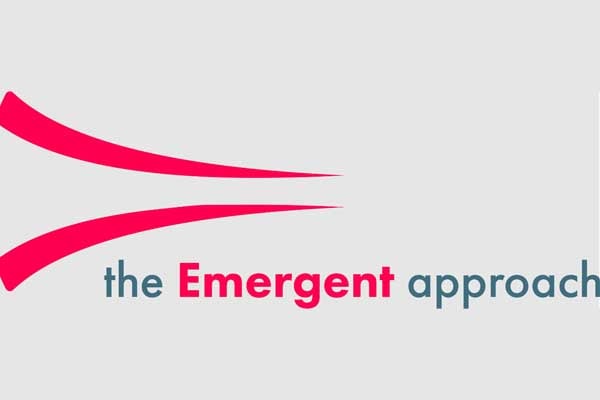
Adaptive Strategy: It's not enough to have a good idea. You need to drive the strategy throughout the company with everybody having a strategy of their own that is consistent and congruent with it.
One of the things that we talk about is we call it the multiple destination trap. If everybody's moving to a different destination, we are working on different things. We work on the alignment of that one destination, which sounds like that's what you had, but then what the breakdown was, the cascading, the integration, the alignment, top, down, bottom, up, and making sure that everybody knew what they need to do and knew what it was. One of the things I tell my clients is, there are 2 or 3 days of planning if you are doing an offsite. In this case, months and months of strategizing, but don't forget the 1,100 or 1,500 days of implementation. It's the amount of communication. It's the amount of engagement.
We will talk about the book. As you look at writing this book, the lessons learned over 25 years in multiple positions. New clarity for strategy, theory, practice, and emergent approach to strategy adaptive design and execution. Talk a little bit about what are the 2 or 3 key lessons that you'd like them to be able to take and implement. One of those is by the book. How can they be better at creating adaptive strategy?
I will even take it down to one. If someone asks me, and this is true for a small business or a large company, it doesn't matter. I'm going to stress this one. It's the vast majority of strategies I have ever seen, strategic plans from the military, government, education, NGOs, small businesses, and large businesses. What they consist of is a fairly high-minded vision and mission big abstract goals, and then long lists of sub-goals, plans, metrics, priorities, pillars, and so forth. I would say that the first thing we can do is take away the lists and ask the question. I'm not the only one to talk about the problem with lists. You have heard that before.
A list of goals is not a strategy. You have to make hard choices. You can't serve everybody. You can't be everything to everybody. What's the key? What is the magic of getting rid of the list and getting a real strategy policy instead? Following people like Rummel, the magic is what's in the way. What do I call it, what's the bottleneck to your aspiration? If your aspiration is short-term growth, what's the bottleneck to that? If your aspiration is a tremendous one like DuPont's, how can we reinvent a company after 200 years for the 3rd time? What's the bottleneck to that?
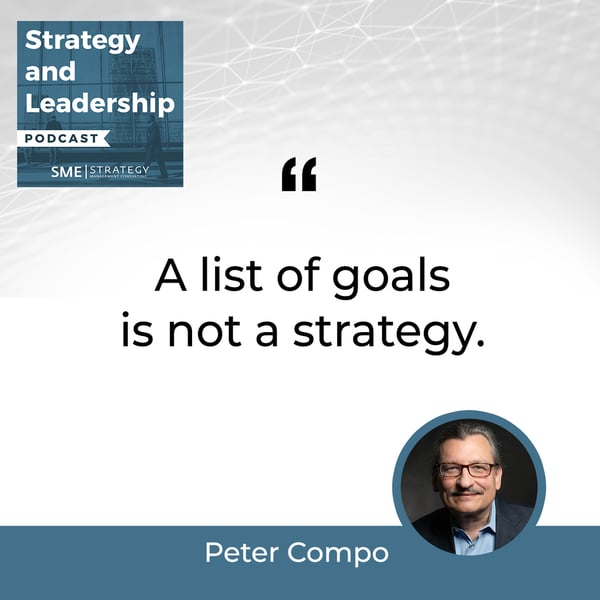
It is finding the bottleneck, what's in the way, and then talking about what's a policy that can bust that bottleneck. This can immediately reduce the lists and try to zero in on the few things that matter. It's connected to what you were talking about before for DuPont. They are trying to make this immense change. What was in the way? What are we fighting here? Is it the organization that doesn't want to buy it? Is it too complicated? Is it that what we are proposing can't be done in the time that we are proposing it? Is it we don't have the right people or too many people? What was in the way and what are we going to do about that?
The problem with lists is so debilitating. There's no pain in them and a real strategy has to have pain. A real strategy has trade-offs. I used to look at these lists and I look at them from other people now. What happens is everybody says, "Who could argue? It's on the list. We are doing everything needed to make this company reinvented. We are doing everything we need to improve and meet our goals."
A real strategy has trade-offs.
If everything matters, nothing matters. I used to say, what happens is it's like everybody in the room gets their bullet point, and then they can go home and go back to what they were doing before, as long as they got their one bullet point. No one asks, "Are all these bullet points consistent with each other?" This is my number one thing, and I have built all kinds of machinery and techniques. Simple techniques that you can use to move from a bunch of lists as a strategy to a strategy that may have lists for implementation, but zeroes in on the bottleneck and on the policy you need to bust that bottleneck.
If everything matters, nothing matters. Zero in on the bottleneck and bust it.
It's one of the things that I appreciate about people who grow up with an engineering background because there's a problem-solving framework. Everything is not the problem. It's, what is the root cause of the problem. What I was taking away from what you were sharing is when you look at adaptive, you are adapting, so there's the proactive, reactive, and then adaptive. What most people are doing, some are trying to be proactive, some are trying to be reactive, but building a good adaptive strategy has you focus on, "What are those key things, and how do we roll with it?"
We don't do five-year plans anymore by nature of the clients that we work with, because it's going to change so quickly and your document is not going to adapt faster than you are. We'd rather say here, "What are those key wins? What are we trying to solve for? What are we going to work on?" Vindicated somewhat as a facilitator that we are doing the right thing as you, which is great. It's so critical. One of the other takeaways I have from you is getting everybody on the same page to be able to do that and make sure that everything's clear. Something you wanted to add there before we finish up?
Two quickies. One is, it's funny you said that about engineers because I was on a panel and a woman on the panel made fun of me. "I can see the engineering coming through in your book." I was like, “Thank you. What a compliment. It's fantastic." The other is, getting everybody on the same page in a way that's not trivial and in a way that you are not repeating the slogans and that you are not just looking at a 55-page PowerPoint deck. This takes real effort. It's a technical effort, not just a personal effort. It's both. People have to understand and internalize what's going on to do this. I spent a whole lot of time trying to give techniques that can happen.
Can I throw one more quick one, because you raised an important point about how fast things are changing? I don't know that there's a problem with a 5-year vision or a 5-year goal. The problem comes in when you think you are done after you have done that and listed a bunch of things. You have to translate that into what's in the way of hitting that five-year goal and asking yourself, "Are you sure that that five-year goal is it? Should we let it go and focus on a year? That's a good discussion.
Even if a 5-year or even a 10-year goal is meaningful, it's only the starting point. You have to ask, "What's in the way now? How are we going to give real-time guidance to the organization on what to do now?" That's a different trick. I don't think they are mutually exclusive. It's when you put in a long-term goal and you are done with it. Now, we will go back to what we were doing before.
It's more the set-it-and-forget-it nature that people think that strategy is not a document, nor is it a vision. What I was going to share is from the past leadership of DuPont at any point, to have the foresight of 100 years is extremely helpful because it's like, "That's the line in the sand. That's where we want to go. Contextually, it was relevant."
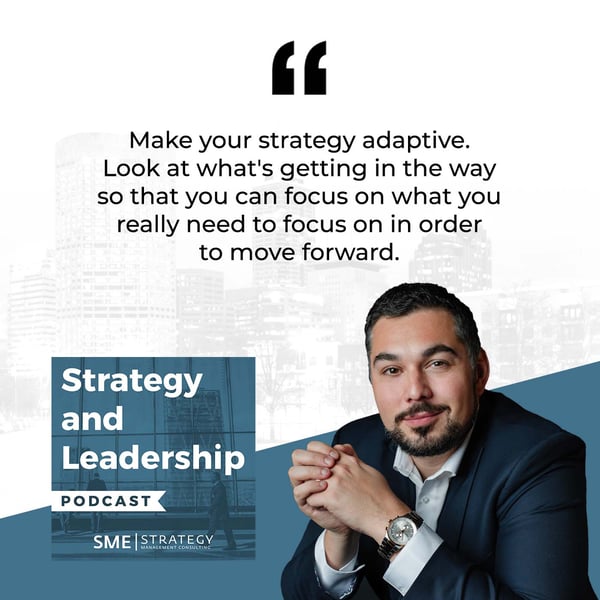
Also, make sure to say, "What does that mean? How do you sustain it?" That's why I was so excited to speak about DuPont as an organization. It's a great organization and historically has made significant improvements to society. I don't think we even think about it when you are like, "I'm using a frying pan, but there's something in there that somebody made."
How they did that year after year and are still doing it. These businesses, some of them are 70 to 80 years old and still are great businesses. It's a testament to the genius of some of these people.
It's not gone. What I'd have our audience look at as saying, "What are those ingredients that make an organization long last that can make your organization, if you so choose, be one of significant impact, long-lasting impact, and that can make big things?” To do that, Peter's main premise is to make your strategy adaptive. Look at what's going to get in the way so that you can focus on what you need to focus on to move forward.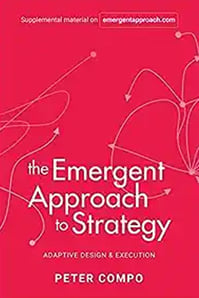
Just before we finish, I want to give a shout-out to our partner Affinity Group. When Peter and I jumped on the call, he said, "I thought you were Canadian. You don't sound Canadian." I say, "There are a lot of benefits to sounding Canadian, but Affinity Group, which is a recruiting staffing agency is in Canada. One of the benefits of hiring talent in Canada is that you pay Canadian prices.”
If you are looking to bring some great people onto your team visit Affinity-Group.CA/SME. You can partner with them. They are awesome people. Tell them we sent you. Peter, thank you so much for being here and for sharing what you shared. Where can people pick up your book? Where can they learn more about the work that you are doing now in 2023?
It's easy. Amazon.com. EmergentApproach.com is my website. Emergent Approach to Strategy is the book on Amazon.com. A lot of information there. You can check me out on LinkedIn, Peter Compo, and get all the information you need.
I appreciate that, Peter. Thank you so much for joining us. It's been a personal pleasure. It was a lot to learn and I had a blast. Thanks for making the time.
It's been fun. Thanks.
---
My guest is Peter Compo. One of the things I'm taking away from this episode is that I like cheating. You get years of consultant experience all baked into one. Seeing what is needed to make a special organization to make special products, and to adapt and have an organization thrive through multiple decades of change. How can you borrow from all of that learning incorporate what works for you inside your strategic approach and recognize that strategy is certainly not a list? It is an intention of where you want to go, but a consistent pursuit of doing the right things in the right order to solve the right problems. If you do that, you will build a resilient organization, and then you will emerge out of the next piece of whatever society brings to us. Who knows what's next? Thank you again, Peter. It's been a pleasure. I appreciate you for tuning in. We will see you next time.
Important Links
- The Emergent Approach to Strategy: Adaptive Design & Execution
- EI DuPont
- Affinity-Group.CA/SME
- EmergentApproach.com
- Peter Compo - LinkedIn
- Amazon.com
About Peter Compo

Peter Compo is a corporate business veteran, scientist, and musician.
After earning a Ph.D. in Chemical Engineering, he held leadership positions in supply chain, product, market, and business management at E. I. DuPont for twenty-five years. He was the director of DuPont ventures and corporate director of integrated business planning.
His book—The Emergent Approach to Strategy: Adaptive Design and Execution—is a bold new theory and practice that brings a new level of clarity to strategy definition and design.
Academics and consultants continue to report chronic failure of strategy practice.


